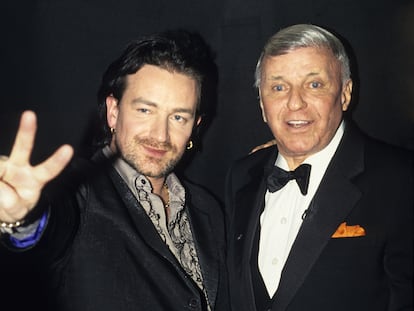Violence, homosexuality and an irresistible James Dean: The scandal called ‘Rebel Without a Cause’
The film that forged the young actor’s legend premiered in 1955 and influenced generations of teens as well as actors like River Phoenix, Keanu Reeves, Zac Efron and James Franco

Rebel Without a Cause premiered in October 1955 on a somber note. James Dean, its star, had died a month prior in a car accident. Its other two leads, Natalie Wood and Sal Mineo, would eventually follow in his tragic wake.
But the film’s message would prove enduring and universal, its influence evident in Grease (1978), West Side Story (1961), and in the characters Fonzie from the series Happy Days and Dylan from Beverly Hills, 90210. Without Dean in Rebel Without a Cause, we never would have gotten — at least, in the form in which we now know them — River Phoenix, Brad Renfro, Keanu Reeves, Zac Efron or James Franco. Even Fry’s outfit on Futurama is inspired by Dean’s look in his iconic film.
Not even Warner Brothers was aware of the script’s potential when production began. Up until then, teen movies were considered B films, and would often form part of double features, inconsequential movies designed to pass time. Young characters lacked their own identity, serving mainly as a foil for adults. But Rebel Without a Cause immortalized the archetype of the melancholic teen who doesn’t understand the world, and who feels as though it doesn’t understand them. As if that weren’t enough to earn it a place in cinematic history, the film also featured the first gay teenager on-screen played by a gay actor, the gorgeous Mineo.
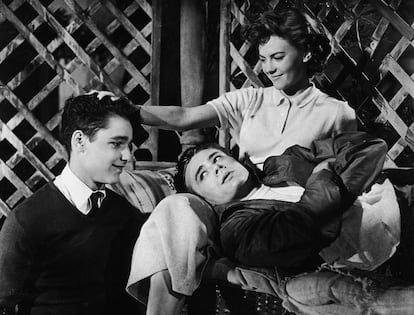
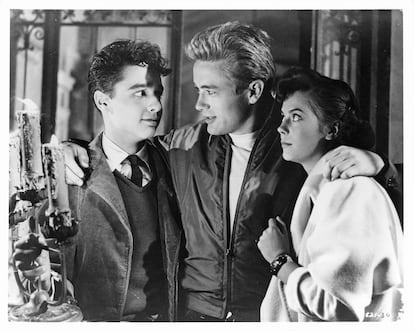
Rebel Without a Cause was meant to be the film adaptation of a text about the psyche of a young delinquent, written by Doctor Robert M. Lindner and published in 1944. Warner had bought the rights to the book in 1946, thinking of Marlon Brando for the lead, but the project never got off the ground. As juvenile delinquency was becoming the primary concern for Americans, studio heads dusted off the script and offered it to Nicholas Ray, one of the day’s hot directors thanks to the success of Johnny Guitar (1954). Ray made it into the movie we know today. From the book it was based on, all that would eventually be left was the title.
“What was all the fuss about Dean, when Dean was so clearly imitating Nick?” wrote Ray’s widow, Susan Schwartz. The director was a restless character who had studied with Frank Lloyd Wright and eventually abandoned architecture to follow his love of theater. Ray was an original and charismatic director, but also problematic. Ignored by Hollywood from the 1960s on, the French New Wave came to his rescue. “The cinema is Nicholas Ray,” Jean-Luc Godard would write.
Ray was the one who suggested a change that proved central to the film’s success: that the juvenile delinquents hail not from the margins of society, as they did in Linder’s book of oppressed backgrounds and broken homes, but rather, be the children of comfortable families from the emerging middle class that had developed in the United States after World War II. This would make for much more terrifying results: any American home could be sheltering a potential delinquent behind its white picket fence. “And they came from good families!” exclaimed the film’s posters.

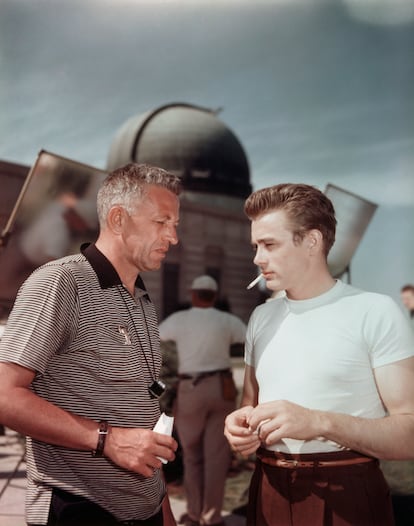
We first meet the movie’s starring threesome, Jimmy, Nancy and Plato, in a police station. But this is not one of those sordid stations in which marginalized young people get lost in the system’s twists and turns. The place in which our main characters have found themselves looks more like a high school principal’s office. The film’s plot is simple: there is love, friendship, gangs and deep feelings. It all takes place throughout the course of a single day. As Ray put it, “when you’re a teenager, 24 hours is a lifetime.”
Casting archetypes
Ray knew right away who would play Jim Stark. Dean had fascinated him in East of Eden (1955), which was the young actor’s only film credit at the time. Despite the warnings from that movie’s director, Elia Kazan, about Dean’s eccentricities, nothing would sway Ray’s resolve. He saw in Dean a kindred spirit. Nonetheless, Warner Brothers recommended alternatives up until the very last moment, suggesting conventional studio studs like Robert Wagner and Tab Hunter. There were never any candidates for the role of Plato besides Mineo, who was already a Broadway star at the time. The role of Judy was harder to fill: Warner Brothers suggested Debbie Reynolds and Carrol Baker, and even, to Ray’s desperation, the explosive Jayne Mansfield. Ray gave her a screen test to appease the studio, but he never even put film in the camera.
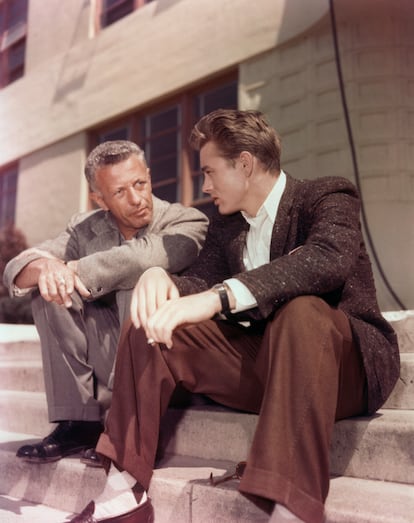
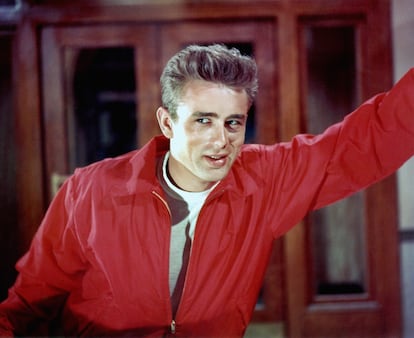
Ray didn’t have much confidence in Wood as a rebel with or without a cause, but she desperately wanted the role to break out of being typecast in childish characters, and also as a way to escape her mother’s iron fist. Ray knew how to take advantage of such distress: days after Wood’s first screen test, he took advantage of her sexually. He was 44, she was 16, the same age as Mineo, who was also sexually violated by Ray. Wood was also in a “relationship” with Dennis Hopper at the time, and he appears briefly in the film. A jealous Ray cut Hopper’s lines from the movie in post-production.
Warner Brothers knew that Dean was a rising star (with only one film under his belt, he was receiving 400 letters from fans a week) and was looking for an appropriately big project for him. But they weren’t sure that Rebel Without a Cause was that project. In fact, it was planned to be a minor, black-and-white film, as Ray wanted, until someone read the fine print in their contract with Cinemascope and realized that they were obligated to film in color. Ray had his doubts about the dazzling new format, fearing that he wouldn’t be able to “fill” the screen. Today, it’s clear that our fascination with the film has much to do with the width of its visual field, just as with its explosive color palette.
To amp up the movie’s realism, Ray hired a true-life gang member, Frank Mazzola, who plays one of Judy’s friends. He was the one who told the production department which cars, games, fights and clothes had to be replaced when the switch was made from black and white to color. Mazzola instructed the wardrobe department to buy clothes at Matson’s on Hollywood Boulevard, where his gang shopped. More than 400 pairs of Levi’s were soiled, washed and dyed because they were showing up in a green hue on screen. It was at Mazzola’s that the red jacket was found which would become one of Dean’s trademarks.
Other masculinities are possible
There was another factor in Rebel Without a Cause as attention-grabbing as its vivid chromatism: Plato’s homosexuality. Ray always knew the character was gay and on his set, that was no problem. Dean was, according to many sources, bisexual, as was Ray, and Mineo was gay. In the film, Plato does not hide his sexuality. In his locker is a photo of Alan Ladd, a 1950s heartthrob. When Plato invites Jim to his house for dinner, it becomes clear that he has fallen in love with him, and intends for their meal to be eventually followed by breakfast. Everyone involved in the filming was aware of this subplot. To drive home the point, Dean told Mineo to look at him the way Dean looked at Wood. Aware of what was brewing, the offices of the Motion Picture Production Code, enforcers of the infamous Hays Code, sent a memo to the head of Warner Brothers, Jack Warner, warning him: “It is of course vital that there be no inference of a questionable or homosexual relationship between Plato and Jim.”
The film explores questions of masculinity, which in its era was lacking references beyond John Wayne. Brando had offered an alternative as the motorcycle gang honcho in Leader of the Pack (1953), and Dean presented a more sensitive version to that turn. The Elvis Presley phenomenon would burst onto the U.S. consciousness a year later. Young people’s new icons were unafraid of showing their feelings, doubts and fragility. This construction of a new identity is evident throughout the film: Jim’s biggest fear is looking like a coward, which is why he tries to win the respect of his high school’s dominant gang, participating in a knife fight and “the chicken run,” in which two cars drive at top speed towards a cliff, with the first to bail out declared the loser.
In Jim’s house, we’re witness to another atypical order of things: his mother is the authority figure and his father is soft, thoughtful and caring. Today, we’d call him deconstructed, back then he was simply labeled henpecked because he cooked for his wife. Jim is horrified at the prospect of ending up like him. However, if we look through today’s eyes, his father seems like a healthy role model. The truly disturbing character is Judy’s father, who, aware that his daughter is no longer a little girl but a woman, and a highly attractive one at that, prefers to violently push her away out of fear of his own desires.
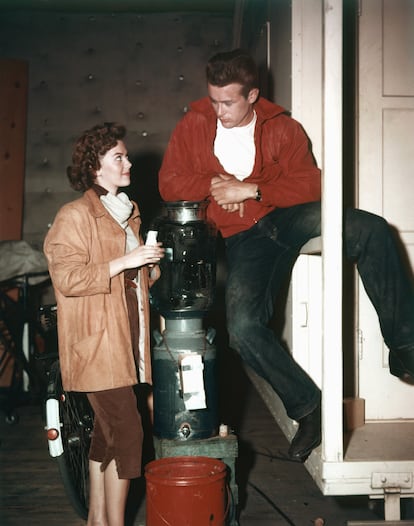
Warner Brothers was fully aware of the massive hit they had on their hands when, on September 30, 1955, Hollywood was shaken to its core. At just 24 years old, Dean had crashed his Porsche on the way to a sports car racing competition. When the production company premiered Rebel Without a Cause just one month after his death, its promotional campaign featured Dean, front and center. The film did not garner universal critical acclaim, and neither did Dean’s acting, which came across as exaggerated at times. Wood and Mineo were nominated for Oscars, Dean was not. Having only appeared in three films, two of them released after his death, Dean is an icon who, through his association with cigarettes and soft drink commercials, is in danger of having his legacy erased as an extraordinary performer who redefined acting.
The movie’s impact was immediate: adolescents filled movie theaters, feeling seen for the first time. Its violent content scared off some distributors, and there were some theaters in the United States that declined to show the film to avoid fights and car races with tragic ends. Just as cinematographic historian Douglas L. Rathgeb explains in the documentary Defiant Innocents, there was fear that the movie would put the community in danger, that it was introducing the idea of creating an alternative family into the adolescent psyche.
Dean’s was not the only tragic death associated with Rebel Without a Cause. Mineo was just 37 when he died from stab wounds from a mugging; Wood drowned at the age of 43 in what continues to be one of the most enigmatic deaths in the movie business. But Rebel Without a Cause’s legacy is bigger than these violent ends. It was the first film to center the lives of adolescents on-screen. One need only consider the state of today’s movies to see that they have never left.
Sign up for our weekly newsletter to get more English-language news coverage from EL PAÍS USA Edition
Tu suscripción se está usando en otro dispositivo
¿Quieres añadir otro usuario a tu suscripción?
Si continúas leyendo en este dispositivo, no se podrá leer en el otro.
FlechaTu suscripción se está usando en otro dispositivo y solo puedes acceder a EL PAÍS desde un dispositivo a la vez.
Si quieres compartir tu cuenta, cambia tu suscripción a la modalidad Premium, así podrás añadir otro usuario. Cada uno accederá con su propia cuenta de email, lo que os permitirá personalizar vuestra experiencia en EL PAÍS.
¿Tienes una suscripción de empresa? Accede aquí para contratar más cuentas.
En el caso de no saber quién está usando tu cuenta, te recomendamos cambiar tu contraseña aquí.
Si decides continuar compartiendo tu cuenta, este mensaje se mostrará en tu dispositivo y en el de la otra persona que está usando tu cuenta de forma indefinida, afectando a tu experiencia de lectura. Puedes consultar aquí los términos y condiciones de la suscripción digital.
More information
Archived In
Últimas noticias
Most viewed
- David King, chemist: ‘There are scientists studying how to cool the planet; nobody should stop these experiments from happening’
- Reinhard Genzel, Nobel laureate in physics: ‘One-minute videos will never give you the truth’
- Mexico completes its trade shift with the entry into force of tariffs on China and countries without trade agreements
- Oona Chaplin: ‘I told James Cameron that I was living in a treehouse and starting a permaculture project with a friend’
- Sinaloa Cartel war is taking its toll on Los Chapitos


